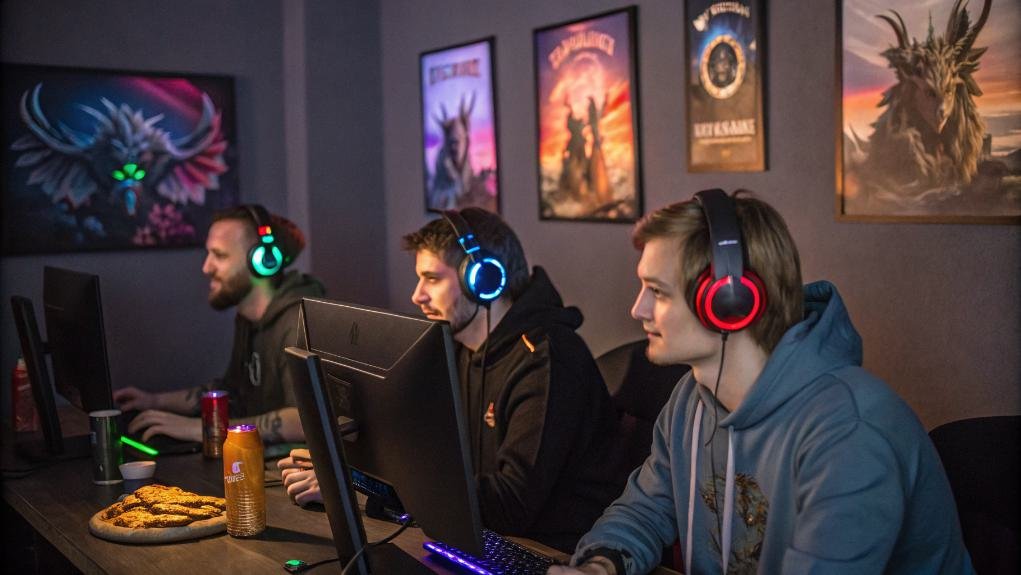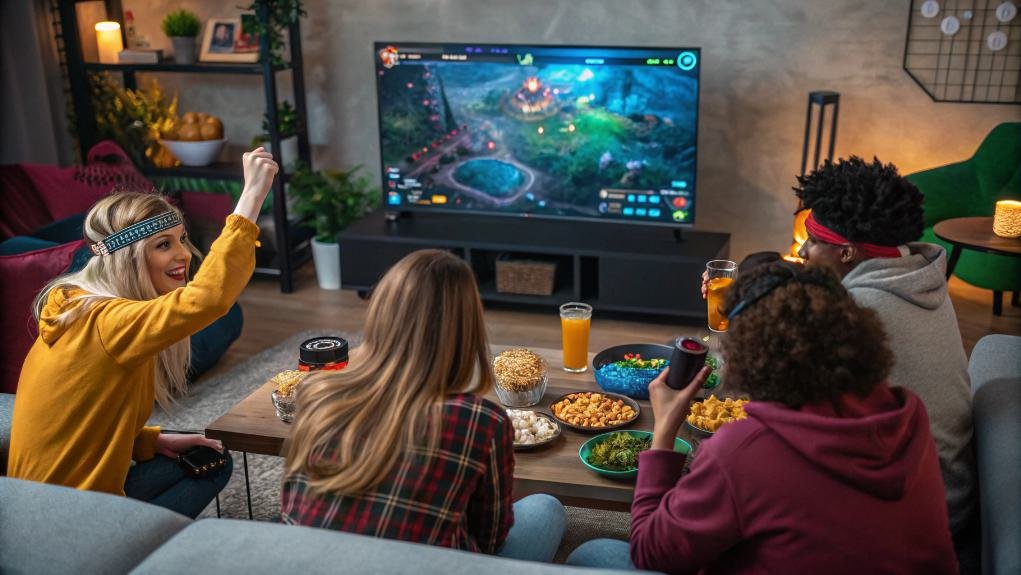In Monster Hunter Wilds, players can enhance their online multiplayer experience by forming strategic squads and using effective communication. Creating and joining lobbies facilitates group play, while understanding links helps streamline multiplayer interactions. Coordinating quests requires clear role assignments and resource management to guarantee teamwork. To address common issues like lag or server stability, proactive troubleshooting is essential. The guide will further explore these topics to optimize every adventure, guaranteeing a rewarding hunting experience.
Key Takeaways
- Form squads by assessing each player's unique skills to assign specialized roles such as Damage Dealers, Tanks, and Support for effective teamwork.
- Use voice chat for real-time communication, allowing for strategy adjustments and regular check-ins to maintain team morale and alignment during hunts.
- Efficiently manage resources by mapping locations and establishing clear roles to streamline gathering, while implementing fair loot-sharing strategies to foster cooperation.
- Address multiplayer issues proactively by checking server stability, optimizing internet connections, and having backup plans for unexpected player disconnects.
- Encourage a positive team atmosphere by sharing strategies and experiences, regularly assessing team dynamics, and adapting gameplay approaches for continuous improvement.
Getting Started With Multiplayer in Monster Hunter Wilds

Getting started with multiplayer in Monster Hunter Wilds can be an exhilarating experience, especially for those who thrive on teamwork and strategy.
Players plunge into an intricate web of multiplayer mechanics that enhance the overall gameplay. Understanding these mechanics is vital; they dictate how hunters interact with one another, share resources, and tackle formidable monsters together.
Effective communication is key, as team dynamics greatly influence mission success. Each hunter's role—be it damage dealer, support, or tank—must align with the group's objectives.
Forming Squads: The Foundation of Team Play
Forming squads is essential for maximizing the multiplayer experience in Monster Hunter Wilds.
Players must understand the squad creation process, assign roles and responsibilities effectively, and prioritize communication and coordination.
Squad Creation Process
Creating a squad in Monster Hunter Wilds is vital for enhancing the multiplayer experience. A well-structured squad relies on strategic squad composition strategies, allowing players to maximize their strengths and cover weaknesses.
Effective leader traits play a significant role in this process; a good leader must communicate clearly, make informed decisions, and inspire team cohesion. This guarantees that each member feels valued and engaged, fostering a sense of belonging.
Leaders should also assess the unique skills of their squad members, assigning roles that complement one another. By focusing on these elements, players can create a balanced squad capable of tackling the game's challenges, ultimately leading to a more enjoyable and successful hunting experience.
Squad Roles and Responsibilities
Understanding squad roles and responsibilities is essential for successful teamwork in Monster Hunter Wilds, as it lays the groundwork for effective collaboration.
By establishing clear role specialization, players can enhance squad dynamics and guarantee each member contributes maximally to the team's success.
Here are three key roles within a squad:
- Damage Dealer: Focuses on inflicting maximum damage to monsters, utilizing high burst attacks and weapon proficiency.
- Tank: Absorbs damage and draws aggro from monsters, guaranteeing the safety of other squad members.
- Support: Provides healing and buffs, enhancing the team's overall performance and survivability.
Balancing these roles can greatly improve a squad's effectiveness in tackling challenges and achieving objectives in the game.
Communication and Coordination Tips
Effective communication and coordination serve as the backbone of any successful squad in Monster Hunter Wilds. Team dynamics improve considerably when players utilize voice chat, allowing for real-time discussions and strategy adjustments.
Clear communication guarantees that each member understands their role and can react swiftly to changing circumstances during hunts. Players should establish a plan before engaging monsters, discussing tactics and target priorities.
This proactive approach fosters collaboration, enabling teams to anticipate each other's moves and respond efficiently. Additionally, regular check-ins during gameplay can help maintain focus and morale.
Creating and Joining Lobbies: A Step-by-Step Guide
Lobbies serve as the central hub for players to connect and commence thrilling hunts together in Monster Hunter Wilds.
Creating and joining lobbies is straightforward, allowing for enjoyable multiplayer experiences. Here's a step-by-step guide:
- Access the Lobby Menu: Navigate to the multiplayer section from the main menu.
- Customize Lobby Settings: Set preferences such as privacy (public or private), maximum players, and quest types. Engaging in lobby customization enhances the experience.
- Join or Create a Lobby: Choose to either create a new lobby or join an existing one. If creating, share your lobby ID with friends for easy access.
Understanding Links: Enhancing Your Multiplayer Experience

While players set out on their monster-hunting adventures in Monster Hunter Wilds, the use of links plays an essential role in fostering cooperation and communication among teammates. Understanding link benefits can greatly enhance gameplay. By implementing effective link strategies, players can coordinate attacks, share resources, and boost each other's performance in battles.
| Link Type | Benefits | Strategies |
|---|---|---|
| Combat Link | Increases attack power | Synchronize attacks |
| Resource Link | Shares items collected | Designate item roles |
| Defense Link | Boosts defense stats | Protect weaker teammates |
| Healing Link | Enhances recovery speed | Prioritize healing roles |
Incorporating these link tactics elevates the multiplayer experience, ensuring a successful hunt and stronger team dynamics.
Coordinating Quests: Strategies for Success
Successfully coordinating quests in Monster Hunter Wilds requires a strategic approach that builds on the foundation of link interactions established in the previous section.
To enhance team synergy and guarantee efficient quest completion, players should adopt the following quest prioritization strategies:
- Identify Key Objectives: Determine which quests yield the most valuable rewards and prioritize them, guaranteeing the team benefits maximally from their efforts.
- Assign Roles: Each player should focus on specific tasks based on their strengths, such as damage dealing, support, or gathering resources, to create a balanced team dynamic.
- Schedule Regular Check-ins: Periodically assess progress and adjust strategies as needed to maintain alignment and momentum throughout the quest.
Communication Tools: Staying Connected With Your Team

Effective communication is the backbone of a successful hunting team in Monster Hunter Wilds. Players can leverage various communication tools to enhance teamwork.
Voice chat stands out as the most efficient method, allowing real-time discussions that facilitate quick decision-making during intense battles. Groups can coordinate strategies, share essential information, and alert teammates to looming dangers without interruption.
However, not everyone may prefer voice chat, so text communication also plays a critical role, especially for players who may be in noisy environments or prefer to keep things discreet. Utilizing in-game messaging options helps maintain clarity and guarantees everyone stays informed.
Managing Resources Together: Teamwork Tips
In "Monster Hunter Wilds," efficient resource management is crucial for team success.
Hunters must adopt effective gathering strategies while ensuring fair sharing and dividing of loot.
Resource Gathering Strategies
Resource gathering in Monster Hunter requires a well-coordinated team effort to maximize efficiency and minimize time spent in the field.
To enhance gathering efficiency, players should consider the following strategies:
- Map Resource Locations: Familiarize the team with key resource locations. Knowledge of where to find essential materials reduces downtime considerably.
- Specialize Roles: Assign specific roles based on each player's strengths. For example, one player can focus on mining, while another gathers herbs, ensuring all types of resources are collected efficiently.
- Communicate Regularly: Use voice or text chat to keep everyone updated on findings and coordinate movements, allowing the team to exploit resource-rich areas together.
Sharing and Dividing Loot
Although hunting monsters can be exhilarating, managing loot effectively is essential for maintaining team morale and ensuring everyone benefits from the spoils.
To achieve the best loot distribution, teams should establish clear roles and responsibilities during hunts. This can prevent disputes over resources and enhance collaboration.
Implementing a system for item trading can also promote fairness; players can exchange items based on individual needs, ensuring everyone leaves with valuable resources.
Communication is key—discussing preferences before starting on a hunt can help align expectations.
Finally, teams should periodically revisit their loot-sharing strategy, adapting it as needed to accommodate different quests and team compositions.
Troubleshooting Common Multiplayer Issues

When players plunge into the thrilling world of Monster Hunter Wilds' online multiplayer, they may encounter a variety of issues that can disrupt their experience.
Common problems include multiplayer lag, connection issues, and unexpected player disconnects. To tackle these challenges, players can consider the following steps:
- Check server stability: Verify the game servers are online and functioning properly, as server instability can lead to matchmaking problems.
- Optimize party synchronization: Encourage all members to maintain a stable internet connection to improve synchronization during quests.
- Use voice chat effectively: Clear communication can help coordinate strategies and mitigate confusion, especially during intense battles.
Addressing these issues can enhance gameplay, guaranteeing a smoother and more enjoyable hunting experience.

